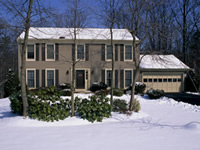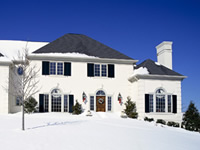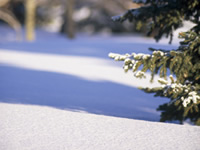Winter Lawn Care
To achieve a beautiful lawn, an effective – year-round – lawn care program is required. Yes, even in winter, you can take steps to help ensure you’ll have a healthy lawn come spring.
 The geographic region in which you live and the winter weather conditions you experience will dictate specifically what lawn care steps should be taken. For example, lawns in some parts of the country do not go completely dormant, so here, remaining vigilant to avoid lawn diseases, such as lawn fungus, is an important component of winter lawn care.
The geographic region in which you live and the winter weather conditions you experience will dictate specifically what lawn care steps should be taken. For example, lawns in some parts of the country do not go completely dormant, so here, remaining vigilant to avoid lawn diseases, such as lawn fungus, is an important component of winter lawn care.
Visit our month-by-month landscape care calendar to see what you should be doing for your lawn.
Winter Lawn Care Tip #1: Avoid Snow Pileup
 Large, heavy piles of snow on your landscape can cause long-lasting damage to lawns and even permanent damage to other elements in your landscape. Remove heavy snow from branches, bushes and shrubs.
Large, heavy piles of snow on your landscape can cause long-lasting damage to lawns and even permanent damage to other elements in your landscape. Remove heavy snow from branches, bushes and shrubs.
Large piles of snow on your lawn can lead to compaction and malign the soil’s ability to properly absorb air, water and nutrients. In addition, concentrated areas of snow pileup can create conditions that are ripe for lawn diseases once the snow starts to melt.
In order to avoid compaction and risk for lawn diseases, try to avoid piling large amounts of snow on your lawn when clearing driveways and walkways. Sometimes, just adjusting the angle of the snow blower’s chute as your clear your property can help to spread out the snow more evenly.
Winter Lawn Care Tip #2: Clear Debris
 Winter winds, snow and ice all can wreak havoc on small branches. Remove branches and other debris as soon as possible. They can be potentially hazardous to anyone enjoying the winter lawn, especially if they get covered with a new blanket of snow. They also will break up into smaller pieces over time, which presents a hazard during mowing in the spring, and the small pieces of branches and twigs can become embedded in your lawn, leading to compaction and thatch buildup.
Winter winds, snow and ice all can wreak havoc on small branches. Remove branches and other debris as soon as possible. They can be potentially hazardous to anyone enjoying the winter lawn, especially if they get covered with a new blanket of snow. They also will break up into smaller pieces over time, which presents a hazard during mowing in the spring, and the small pieces of branches and twigs can become embedded in your lawn, leading to compaction and thatch buildup.
Winter Lawn Care Tip #3: Observe
The mid-winter thaw, warmer winters, or approaching spring all present ripe conditions for lawn diseases such as snow mold and other types of lawn fungus. To reduce your risk, break up large piles of snow. This will improve drainage conditions on your lawn.
Once the snow has cleared, professional lawn care providers can examine grass plants to check for snow mold and leaf diseases including lawn fungus. If you think you have an active disease on your property, our professional lawn care providers can come out and review your lawn with you to determine the best lawn care program to cure lawn diseases before spring comes.
Click or call today to arrange a complimentary consultation from our fully trained and certified arborists for lawn care, tree care and fertilizer services from SavATree. Contact the office nearest you.





